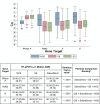Saliva as alternative to naso-oropharyngeal swab for SARS-CoV-2 detection by RT-qPCR: a multicenter cross-sectional diagnostic validation study
- PMID: 35871257
- PMCID: PMC9308781
- DOI: 10.1038/s41598-022-16849-1
Saliva as alternative to naso-oropharyngeal swab for SARS-CoV-2 detection by RT-qPCR: a multicenter cross-sectional diagnostic validation study
Abstract
Saliva has been demonstrated as feasible alternative to naso-oropharyngeal swab (NOS) for SARS-CoV-2 detection through reverse transcription quantitative/real-time polymerase chain reaction (RT-qPCR). This study compared the diagnostic agreement of conventional NOS, saliva with RNA extraction (SE) and saliva without RNA extraction (SalivaDirect) processing for RT-qPCR in identifying SARS-CoV-2. All techniques were also compared, as separate index tests, to a composite reference standard (CRS) where positive and negative results were defined as SARS-CoV-2 detection in either one or no sample, respectively. Of 517 paired samples, SARS-CoV-2 was detected in 150 (29.01%) NOS and 151 (29.21%) saliva specimens. The saliva-based tests were noted to have a sensitivity, specificity and accuracy (95% confidence interval) of 92.67% (87.26%, 96.28%), 97.55% (95.40%, 98.87%) and 96.13% (94.09%, 97.62%), respectively, for SE RT-qPCR and 91.33% (85.64%, 95.30%), 98.91% (97.23%, 99.70%) and 96.71% (94.79%, 98.07%), respectively, for SalivaDirect RT-qPCR compared to NOS RT-qPCR. Compared to CRS, all platforms demonstrated statistically similar diagnostic performance. These findings suggest that both conventional and streamlined saliva RT-qPCR are at least non-inferior to conventional NOS RT-qPCR in detecting SARS-CoV-2.
© 2022. The Author(s).
Conflict of interest statement
This endeavor was financially and logistically supported by Mount Grace Hospitals, Inc. which had no role in the design of the investigation and in the analysis of the results. Dr. Vivencio Jose P. Villaflor III is a member of the board of directors of Dagupan Doctors Villaflor Memorial Hospital. The proprietary instruments and materials used in this investigation are commonly and routinely utilized in our area of research and country, and the manufacturer of these products was not involved in any direct or indirect manner in the conduct of this research.
Figures


References
-
- COVID-19 Tracker. Department of Health (Philippines). https://www.doh.gov.ph/covid19tracker (2022).
Publication types
MeSH terms
Substances
LinkOut - more resources
Full Text Sources
Medical
Miscellaneous

